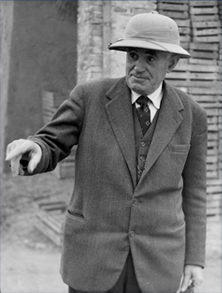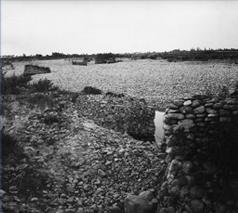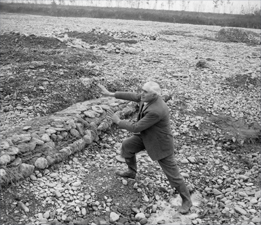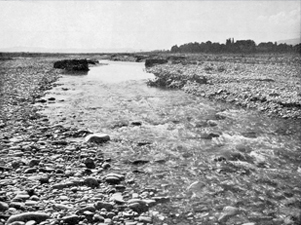|
|
| |
 |
| |
The Po flows just over 50 kilometres north of Parma, but the homeland of Silvio Corradi is crossed by a number of other rivers and streams, such as the Baganza, Parma and Taro. It was only natural that for a region with a significant agricultural activity water courses played a role of major importance in the lives of everyone, connected to the needs for irrigation but also the constant danger of floods.
The newspaper The Parma Gazzette (Gazzetta di Parma) attributed to Silvio Corradi the epiteth The Tamer of Rivers. We do not know if the journalist was inspired by the British explorer Henry Morton Stanley, renowned for his adventures on the Congo River and known by the natives as Rock Crusher.
The fact is that Silvio Corradi, who had maintained from his African experience the frequent habit of wearing a pith helmet, could easily bring to mind a character such as Stanley.
His first approach to the problems of a river was in October 1913, when in military service in Vicenza. Over then the River Astico, the creek which flows east of the city, was in full flood and he was concerned by the behaviour of water in the presence of masses of debris transported downstream.
After the First World War, around 1920, he decided to study in depth the subject and performed the first studies on possible systems to deposit the material that water carries during floods.
This first experience was greeted at first with scepticism by those responsible for controlling the waters. |
|
|
|
| |
 |
In 1925 he devised a system that would allow the automatic adjustment and gradual flow of water and he looked for the support needed to progress to practical tests of his idea. This path proved long and tedious.
Silvio Corradi invented a special device to increase the speed of flow of major rivers consisting of linked and anchored barges equipped with underwater floodgates inclined to determine a fall in current towards the bed. The device created a water flow that excavated the central part of the river, avoiding the accumulation of material. Corradi said the idea had come to him observing small channels where the ducks were swimming. The ducks move the water to swim using their webbed feet and the "humpback" caused by debris was not formed. The banks were kept more intact in contrast to the channels not frequented by the birds He obtained the same result for channelling strong flowing streams and rivers by placing in the middle of the streams, at more or less regular intervals, wire mesh cages filled with stones.
From observing the behaviour of water Silvio Corradi took the view that the property of a water current is to excavate the bed of the stream where there is increase in speed and ,on the contrary, to deposit material where speed decreases. |
|
| |
| He explained that water, when it encounters an obstacle, excavates around it creating a narrowed section, an increase in speed, a lowering of the river bed and continues to draw new water to the vicinity of the obstacle. For this reason the banks and especially the defences built to protect the banks and adjacent land end up being a booster to the water digging and undermines the foundations of these works. This system received on July 11, 1937 a patent after it had been tested on a stretch of the River Parma affecting the properties of the Marquis Antonio Meli Lupi di Soragna. “ The Corradi System" was submitted to the Central Committee for the Examination of Inventions on March 29, 1938 but received a negative opinion. The inventor did not lose heart. Although Italy was again at war, in 1942 he obtained a meeting with Prof. Marco Visentini, engineer and president of the Higher Council of Public Works. On June 1, he suggested that Corradi contact the Consortium for the Hydraulic Defence of the Torrente Parma to conduct a practical experiment. The process of proving the system ran aground as the Consortium did not reply. |
| |
 |
| |
In the course of 1943 Prof. Marcello Lelli, engineer and director of the Institute of Hydraulics in Genoa, compiled a detailed report which he submitted to the Civil Engineers and the Consortium of Parma. He asked them to consider the proposal "to correct a section of the Torrente Parma by the application of the Corradi System“. The general situation in Northern Italy in that period led to a further delay but in 1945 Corradi and Lelli were able to test the method in the laboratory, creating a scale model of the loop of a stream and obtained favourable unequivocal results.
This lead to agreement in October 1946 with the Civil Engineers of Parma to pilot the scheme on a very small scale (with only one cage) at Parma, in the village of Porporano. On November 27 technicians verified that the solution had worked, with the filling of a pit that had been caused upstream by the water, as the result of a river bank defence. |
| |
| |
This time the validity of the idea was recognized and on December 30, 1948 the engineer Visentini promised his support for experimentation on a larger scale, with the allocation of a budget of two million lire. In February 1949, while the work was in progress, there was a full flood of the river. Nonetheless, though unfinished, the system resisted, demonstrating again the validity of the idea. The actual funding, however, was slightly more than 500,000 lire and Silvio Corradi had to contribute from his own pocket with the other 500,000 lire, but this was not sufficient to complete the project.
On February 6, 1950 Silvio Corradi, received a letter announcing that the expenses incurred by him would be reimbursed and in 1951 the Ministry of Labour created an experimental station involving a 2 km stretch of the River Parma near Vigatto with a budget of more than 3,200,000 lire. The work continued for two years until March 1953, but with frequent interruptions due to lack of manpower. During that period there were several high tides of the river. The system proved to work very well with no flooding in the experimental stretch of the river. |
 |
|
| |
This time the official recognition of the success of the trial was obtained, but this was not followed by a wider implementation of the system.
In the field of hydraulics Silvio Corradi had other insights that after thorough study and research led to a variety of patents such as "A procedure for extraction of water from rivers and streams in general, for purposes of irrigation etc-" , which he obtained in February 1950. In 1951, when the River in the Polesine area was overflowing, Silvio Corradi suggested the use of boats suitably modified, adjusted according to a system that was proposed some years ago when he studied the method for facilitating the flow of water into the sea. As "fallout" of this research he also developed a device to purify river water from the materials transported. With the good results obtained by experiments on channelling of the river, and recovery of vast areas of fertile land along the banks, the inventor of Vigatto secured the esteem of the local farming community. However, although some of his principles were accepted, he was never officially asked to perform work of this kind. On August 9, 1961, for future reference and to prevent anyone in the future from stealing his ideas, he deposited with a notary documents containing his addresses on the arrangement of the Po delta. This is virtually the last act of documented research by Silvio Corradi on watercourses. |
| |
|
|





